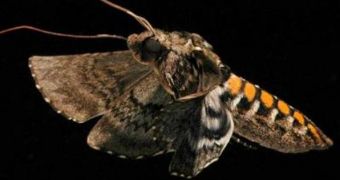For quite some time now, researchers and naturalists have believed that insects fly best if they keep their wings rigid. This conclusion was brought forth by the fact that mechanics and aerodynamics of insect flight seemed to hint in that direction at first. But a new investigation has proven that it's, in fact, a lot easier for moths, for instance, to fly when they flex and deform their wings. This was made obvious when researchers started using a high-speed camera to record the creatures' flying patterns, and noticed that the wings never stood rigid, as first thought.
Experts from the University of Washington were behind the new study, which once and for all put an end to speculations regarding how insects flied. UW biology doctoral student Andrew Mountcastle says that, “The evidence indicates that flexible wings are producing profoundly different air flows than stiff wings, and those flows appear to be more beneficial for generating lift.” By combining laser light and high-speed digital video, in a technique known as particle image velocimetry, the team at the university was able to study the flow of air on, over, and around the wings of the tobacco hawkmoths (Manduca sexta).
The team likened the wings of these moths to a piece of fabric stretched over a stiff leading edge. The wings in themselves have no muscles of their own, and are entirely driven by muscles inside the body of the insect. Naturally, in a process similar to what happens when you snap a heavy beach towel to get rid of the sand, the wing is forced upwards and then downwards, with the force moving it acting on it only from one end of the wing. This means that the tip always sort of “lags” behind, and makes the wing bend either in or out, depending on the direction of the motion.
“Our results show that the flexible wings are doing a better job of generating lift-favorable momentum than are the stiff wings. They also are inducing airflow with greater overall velocity, which suggests the production of greater force for flight. As a biologist, I am interested in the evolutionary implications of what we see here. To understand the selective pressures that have acted on wings through their evolution, we have to understand the functional implication of wing forms and their material properties. There also is interest in developing tiny insect-like flapping robots, and certainly these results are relevant to that field,” Mountcastle adds.

 14 DAY TRIAL //
14 DAY TRIAL //